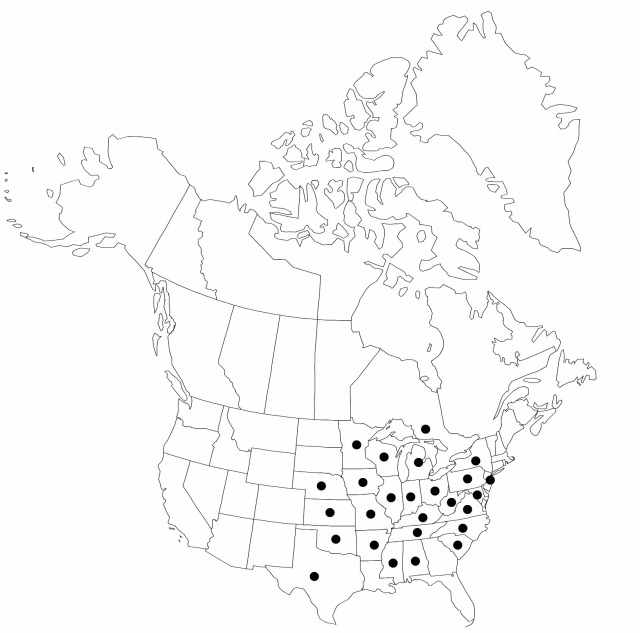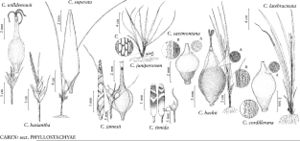Carex jamesii
Ann. Lyceum Nat. Hist. New York 1: 67. 1824.
Culms 4–37 cm; cataphylls with concave cells. Leaves: basal sheaths golden brown to dark-brown; blades green, eceeding culms, 0.8–4.8 mm wide, herbaceous, margins green, scabrous. Lateral spikes 1–5, basal, on spreading to nodding peduncles. Terminal spikes with staminate portion 3–13flowered, (4.2–) 5.814.5 × 0.40.8 mm; pistillate portion 14-flowered. Pistillate scales green, margins connate, hyaline, white, occasionally tinged reddish-brown; proximal scales with margins 1.4–3 mm, apex long-acuminate; distal scales with margins 0.4–0.8 mm wide, apex acuminate, awnless. Staminate scales ovate, 1.1–1.8 (–2.1) × 1.2–1.5 mm, 0.12–0.25 (–0.75) length of staminate portion of terminal spike, margins hyaline, white, often with reddish-brown subapical band, apex truncate or broadly obtuse. Anthers 0.6–1.6 mm. Perigynia green to bronze, globose to ellipsoid, 4.4–7.2 × 1.9–2.4 mm, tightly enveloping achenes, apex abruptly tapering; beak 1.6–3.8 mm, scabrous. Stigmas filiform, flexuous, strongly papillose. Achenes dark-brown, globose to ellipsoid, 2–2.6 × 1.7–2.4 mm. 2n = 66, 70.
Phenology: Fruiting spring–summer (early May–mid Jul).
Habitat: Mesic, rich ravines, slopes, and flood plains in hardwood forests, on lime-rich substrates
Elevation: 100–400 m
Distribution

Ont., Ala., Ark., Ill., Ind., Iowa, Kans., Ky., Md., Mich., Minn., Miss., Mo., Nebr., N.J., N.Y., N.C., Ohio, Okla., Pa., S.C., Tenn., Tex., Va., W.Va., Wis.
Discussion
Selected References
None.
Lower Taxa
"shortened" is not a number."widest" is not a number.".5mm" is not declared as a valid unit of measurement for this property.".8" is not declared as a valid unit of measurement for this property.
